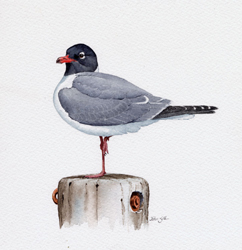Breeding Bird Atlases (BBA)
Find a Bird - BBA1
Breeding Bird Atlas 1 Species Accounts
Laughing Gull
Larus atricilla
Egg Dates
May 18 to July 12
Number of Broods
one

The Laughing Gull can be seen along much of the Massachusetts coastline from April to November but is confined as a breeding bird to one or two of the outermost islands. Until 1972, the only recorded colony was on Muskeget Island. Abundant there in the mid-nineteenth century, Laughing Gulls were almost extirpated by plume hunters in the 1870s but recovered under protection in the 1890s, and increased dramatically to more than 20,000 pairs from 1936 to 1945. The island was then occupied by increasing numbers of Herring Gulls, and Laughing Gulls decreased steadily; the last 120 pairs were washed out by a hurricane in 1972. They then moved to Monomoy, where they prospered and increased to 1,000 pairs by 1981. However, the total Massachusetts population has now decreased to about 500 pairs, and many of the birds have moved to New Island in Orleans.
Laughing Gulls arrive in Massachusetts in early April and occupy the breeding areas in early May. One- and two-year-old birds migrate north and can be seen around the breeding colonies, but most do not nest until they are at least three years old. They forage along the shore and in tide rips, tidal bays, and inlets. Most birds feed within 10 miles of the breeding colony, but birds in breeding plumage can be seen regularly up to 40 miles away in Buzzards Bay and at Provincetown and Plymouth. They feed predominantly on crustaceans and other invertebrates, which they pick from the surface of the water. Some feed on Sand Eels or other fish swimming near the surface, while others scavenge at sewage outlets or around boats. They sometimes catch flying insects in the air. Occasionally, they will chase terns at the breeding colonies and steal fish from them. Laughing Gulls are rarely seen inland, but a few visit ponds on Cape Cod, and a few birds at Monomoy bring freshwater fish to their young. They nest on sand dunes, usually selecting areas of dense Dunegrass or Poison Ivy; occupation by Laughing Gulls seems to promote the spread of Poison Ivy into their nesting areas.
The most characteristic call on the breeding grounds is a maniacal laugh, ha-ha-ha-ha-ha-ha-haah-haah-haah-haah, usually given in display to other birds. When disturbed from the nesting area, Laughing Gulls circle or hover overhead with a babble of yelping alarm calls. The flight call is a gooselike hap-hap. Laughing Gulls commonly feed in groups, and they rest in flocks on the sand, on jetties, or on the water. During the breeding season, off-duty birds collect in flocks in an open area within or adjacent to the nesting area.
Laughing Gulls usually lay two or three eggs in a nest built from dried vegetation. Most eggs are laid between May 21 and June 10, although a few birds do not lay until late June. Nests are usually well concealed under dense clumps of Dunegrass or other vegetation. The incubation period is ordinarily about 24 days but is sometimes extended to 30 days or more when nocturnal predators lead the birds to desert the colony at night. Both parents incubate the eggs and feed the young. The chicks spend the first few days in the nest but then move into dense cover. They emerge when they are ready to fledge in late July and early August and then collect in large flocks at the water’s edge. Laughing Gulls often raise two or more young per pair to fledging, but predation by owls, Black-crowned Night-Herons, or Herring Gulls often severely limits productivity.
After the breeding season, Laughing Gulls disperse along the coast, and, in August through November, flocks of up to 500 birds can be seen around the Cape and Islands, with smaller numbers northward to Boston Harbor and on the North Shore. Banded birds from New Jersey, Virginia, and North Carolina wander north to Massachusetts at this time. Hurricanes occasionally bring large numbers of these birds from the south in September or October. Most birds have left Massachusetts by late November, but a few stragglers can be seen on Christmas Bird Counts or even in January and February.
Banding has shown that juvenile Laughing Gulls raised in Massachusetts migrate to the Pacific coast of Central America and to northwestern South America, but some adults may winter in Florida or other southern states.
Map Legend and Data Summary
Atlas 1 data collected from 1975-1979


Note: locally common at Monomoy National Wildlife Refuge and New Island, Orleans (1980s on); Plymouth Beach since late 1990s
Ian C. T. Nisbet



